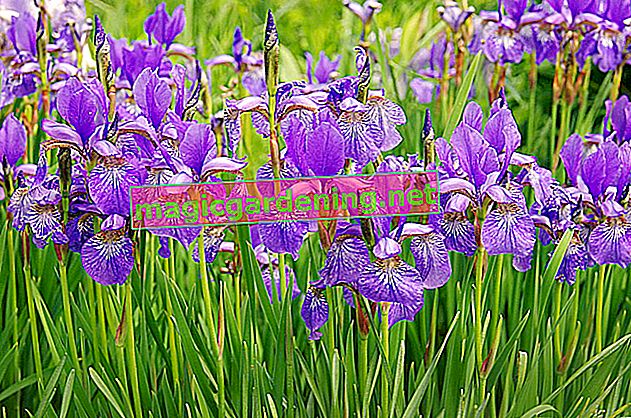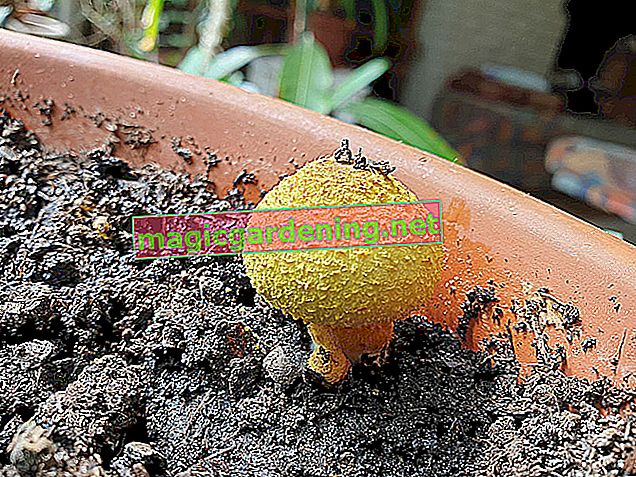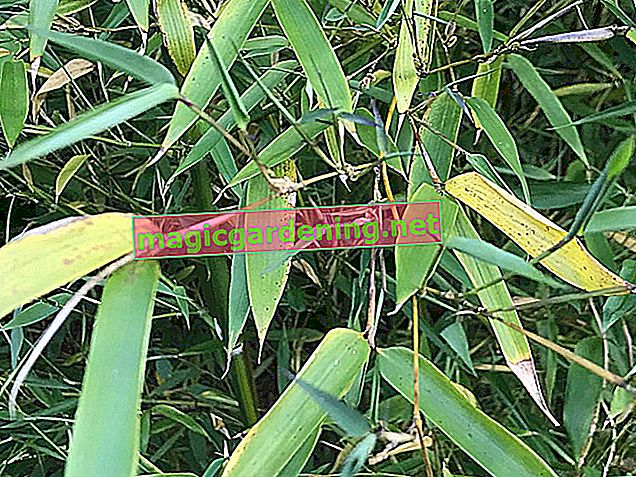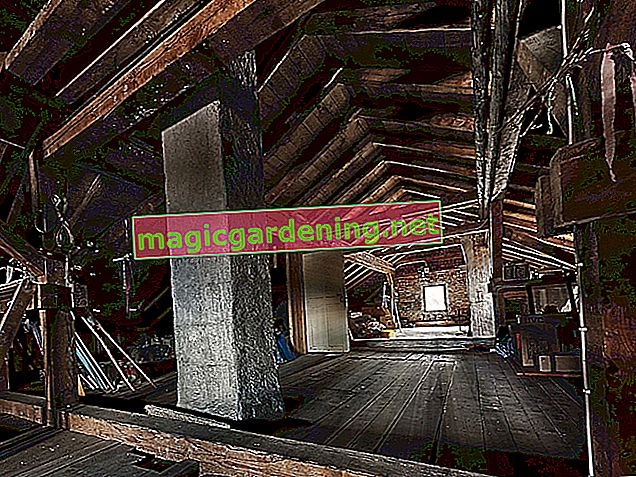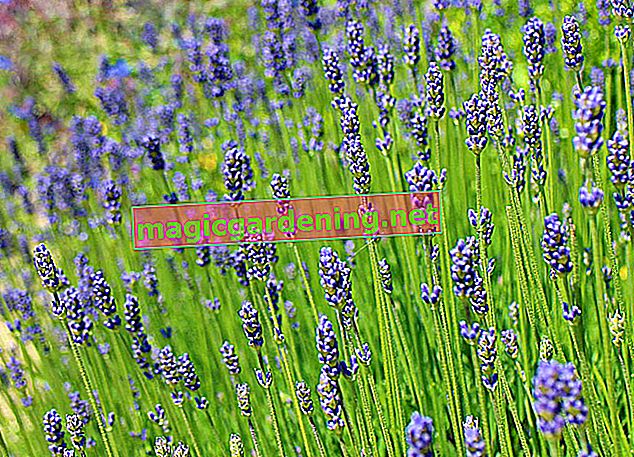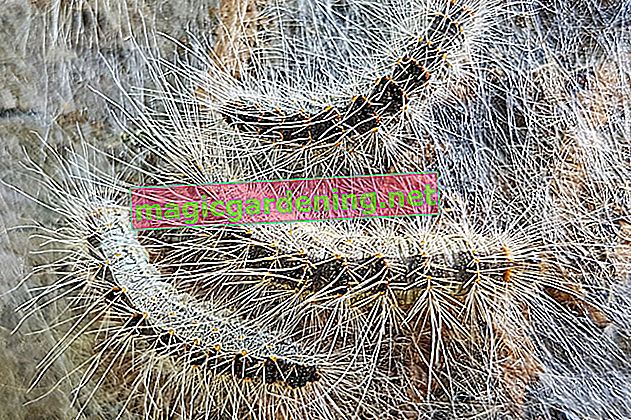
Plant aralia properly
In the sunny to partially shaded, wind-protected location, create a spacious planting pit in the nutrient-rich, humus-fresh soil. So that the strong root runners do not make themselves independent, we recommend a 60 cm deep root barrier. The potted aralia is meanwhile placed in water until no more air bubbles rise. Then position the potted root ball in the middle of the pit. Before you fill the cavities with soil, enrich the excavation with compost, horn shavings (€ 6.39 at Amazon *) and a little rock flour. (14.95 € at Amazon *) Extensive watering on the day of planting as well as in the following period paves the way to vital growth and rapid rooting.
also read
- The flowering of the aralia: appearance and flowering period
- Aralia - edible or poisonous?
- Caring for the aralia - water, fertilize, cut and more
Care tips
In an adequate location, the Japanese aralia hardly demands any gardening attention from its gardener. This is how maintenance works smoothly:
- Keep the soil in the bed and the substrate in the pot evenly moist
- An organic start fertilization in March / April, followed by another dose shortly before the start of flowering
- Cutting and thinning during the leafless winter time
Since the Japanese angelica tree is one of the moderately poisonous ornamental plants and is mostly armed with thorns, we recommend wearing protective gloves for all planting and maintenance work.
Continue reading
Which location is suitable?
The aralia prefers a sunny to partially shaded location, preferably sheltered from the wind and warm. In order for the ornamental wood to create its opulent flowers, leaves and berries, the soil must not be too poor. A humus, well-drained and freshly moist soil elicits its most beautiful aspects from the Asian immigrant.
The correct planting distance
A Japanese Aralie only sets itself perfectly in scene with its Asian charisma where there is enough space available. The pure species therefore requires a planting distance of 4 m to the right and left. For the more compact hybrids, we recommend a distance of at least 2 m in each direction.
What soil does the plant need?
The angelica tree feels at home in nutrient-rich, humus-rich and freshly moist soil. A good drainage is of the highest relevance so that there is no waterlogging during rainy seasons. Therefore, choose a sandy-loamy soil that may have a slight lime content.
What is the best time to plant?
The majority of tree nurseries and garden centers offer the Aralia in containers. This gives you the opportunity to plant the ornamental shrub during the entire growing season. Ideally, choose a mild day between mid-April and mid-May or between early September and mid-October.
When is the flowering time?
From August to September an impressive display of flowers rises above the mighty pinnate leaves. You can look forward to huge panicles, dotted with small umbellate flowers. A single inflorescence will last for 1 to 2 weeks before wilting. Do not cut off the withered flower panicles, because just a few weeks later they will turn into decorative fruit clusters with dark mini berries.
Cut aralia properly
Do not cut the late-blooming Japanese aralia until it has completely drawn in and shed the foliage. A frost-free day between December and February is a well-chosen date for a cut back and shape. Shoots that are too long can be shortened by up to two thirds. Place the scissors just above an outward-facing bud. Don't hope for another branch. A devil's cane is very cautious in this regard. Every cut goes hand in hand with a thorough clearing. Remove dead wood at the base and cut out other stunted branches. Please consider the thorns on the bark and take appropriate precautions to avoid injuries.
Pour Aralia
A freshly planted aralia thirsts for plenty of water to promote rooting in the soil. Adult shrubs are satisfied with the rain and are only watered in summer drought. In contrast, there is a need for regular watering in the tub, as the substrate dries out more quickly.
Fertilize aralia properly
Fertilize the aralia in the bed at the start of the season in March / April and again shortly before the start of flowering in July with compost and horn shavings. If the devil's cane thrives in the bucket, apply a mineral-organic liquid fertilizer every 30 days from April to September and pour in again.
Overwinter
The Asian beauty is winterproof down to - 25 degrees Celsius. We therefore recommend explicit winter protection in beds only in the year of planting and in pots. Before the first frost, cover the root disc of a freshly planted aralia with leaves and brushwood. Wrap a bucket with fleece, foil or jute tape and place it on wood in front of the south wall of the house.
Propagate Aralia
For aralia propagation, choose from the following methods:
- In early summer, cut half-lignified head cuttings, place in pots and keep moist until roots are covered
- In spring or autumn, cut off 5-6 cm long root strands and let them root in the pot as cuttings
- Sow the seeds behind glass, sieve 2-3 cm thick and motivate them to germinate at 20-23 degrees Celsius
So that the moderate level of toxins cannot cause skin irritation, we recommend wearing gloves for this work and for any contact with the devil's cane.
Continue reading
Aralia in the pot
In order for the aralia to thrive in the pot, various criteria must be taken to heart. A volume of 20-30 liters is just as relevant as a location protected from the wind so that the mighty ornamental shrub does not tip over. As a substrate you can use any common compost-based potting soil, enriched with expanded clay, fine grit or sand for the best water drainage. A few pottery shards above the floor opening reliably prevent waterlogging.
Is Aralia Poisonous?
The plant paths of a Japanese aralia are permeated by moderately toxic saponins. We advise against consuming the flowers, leaves or berries. Pets also suffer from unpleasant symptoms of poisoning when they nibble on the leaves or eat the fruit. So settle the devil's cane out of the reach of children, dogs, cats and small animals.
Continue reading
Nice varieties
- Aureovariegata: Very beautiful variety with yellow-green variegated leaves and white flowers; Height of growth 300-500 cm
- Silver Umbrella: Impresses with up to 1 m long pinnate leaves and abundance of flowers in summer; Growth height 400-1000 cm
- Devil's cane: creamy white flower umbels, dark green leaves and black berries in autumn; Growth height 350-500 cm
- Variegata: Picturesque variety with white-green marbled leaves, white flowers and spherical fruits; Growth height 500-700 cm


